How Much Does an OSHA/ASME Compliant Rigging Inspection Cost? [2022]
Bringing a third-party rigging inspector into your facility shouldn’t be considered an added expense. If you have the proper compliance processes in place and your employees are properly trained, then a periodic rigging inspection should really just be a validation of how well those programs are working.
If you’re in charge of maintaining your company’s manufacturing equipment and machinery, take a second to think about how much responsibility actually falls on your shoulders. On a day-to-day basis, you may be responsible for the upkeep and maintenance of any of the following:
- Bridge cranes, workstation cranes, gantry cranes, or jib cranes
- Hydraulic presses
- Tool and die equipment
- Tow motors, man lifts, or scissor lifts
- CNC machines, lathes, or mill machinery
On top of all that, you’re probably also responsible for rigging inspections and maintenance of any overhead lifting slings, hardware, below-the-hook devices, and personal fall protection that your employees use on a daily basis.
As we all know, OSHA and ASME have some type of standard or regulation related to the usage and inspection of each piece of equipment in your shop or facility. It can make your head spin trying to make sure that your facility is in good standing with sanctioning bodies and that your employee’s equipment is compliant, in proper working condition, and safe for them to use.
At Mazzella, we have one of the few business units in the industry that is dedicated solely to the inspection of lifting and rigging equipment, below-the-hook lifting devices, and personal fall protection equipment. Our growing team of Rigging Inspectors are fully certified through an accredited training program to understand all of the related ASME standards and assist you in getting your company’s lifting and rigging inspection program in compliance.
How Often Should You Inspect Your Rigging Equipment?
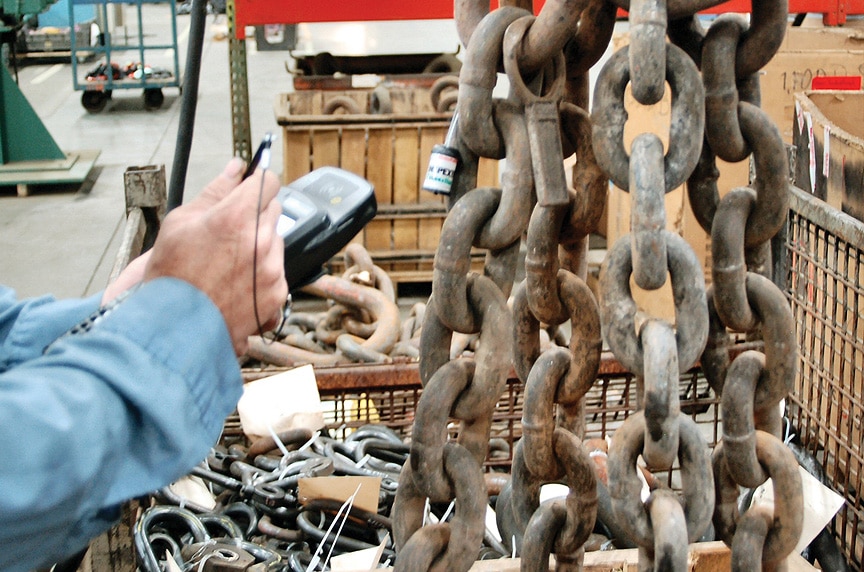
There are two industry standards that exist to provide the end-user with guidelines for inspection and criteria that warrants removal from service: OSHA 1910.184 and ASME B30.9 Slings.
Initial Inspection (prior to initial use)
Best practice is to inspect all rigging equipment upon receiving it from your supplier. For lifting slings, double-check the sling tags to make sure it’s what you ordered and that the rated capacity meets all of your project specifications and lifting requirements.
Frequent (daily or prior to use)
Designate a Competent Person to perform a daily visual inspection of hardware, slings, and all fastenings and attachments for damage, defects, or deformities. The inspector should also make sure the rigging gear being used for the lift meets the specific job requirements it’s being used for.
Users can’t rely on a once-a-day inspection for slings, shackles, hoist rings, hooks, etc. if they’re being used multiple times throughout the day. Damage to rigging equipment can occur on one lift and best practice is to perform a visual inspection before any shift change or changes in lifting application. Because shock loads, severe angles, sharp edges, and excessive heat can quickly cause damage to a lifting sling, the user should inspect all slings prior to each lift.
Periodic Inspection
A documented periodic inspection is performed by either a professional service provider, or a Qualified Person every 12 months (at a minimum) and monthly to quarterly in more severe service conditions. The following are all determining factors in scheduling the frequency of a periodic inspection:
- Frequency of use
- Severity of service conditions
- Nature of the lifts being performed
- Experience gained on the service life of lifting slings used in similar applications
ASME provides these additional periodic inspection guidelines based on the service of any type of lifting sling:
- Normal Service – Yearly
- Severe Service – Monthly to Quarterly
- Special Service – As recommended by a Qualified Person
Depending on the severity of the operating environment and frequency of use, your business may decide that a more thorough sling inspection should occur more often than the minimum yearly requirement.
Periodic inspections are required to be documented per ASME B30.9 Slings and records retained.
As an employer, you are required to maintain a record of the most recent thorough inspection—however, individual records for each sling that was inspected are not required. Failure to maintain and retain inspection records is one of the most common issues we see that can prevent a company from reaching full OSHA compliance.
What Can You Expect During a Rigging Inspection?
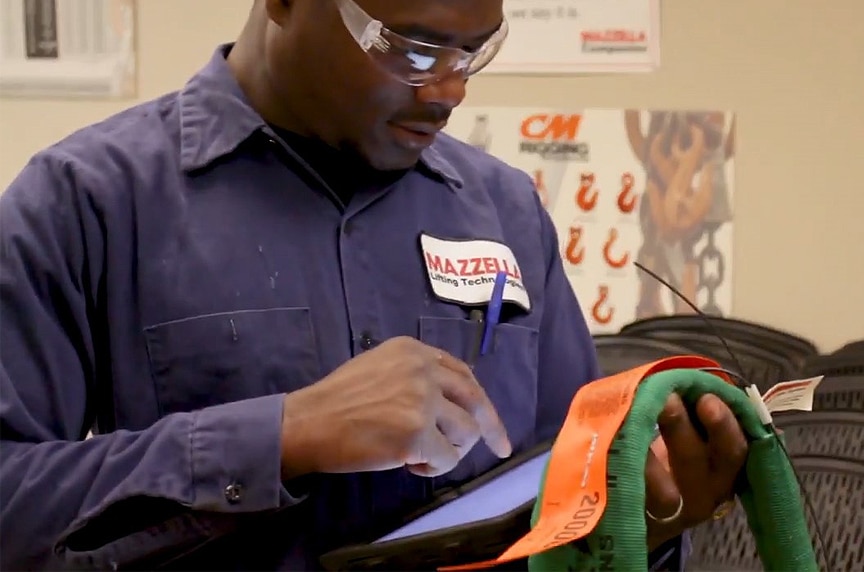
To get the process rolling, a customer reaches out to a company who performs rigging inspections because they know they need some sort of documented third-party inspection of their rigging equipment. Oftentimes, we hear, “I know I need my slings inspected…tell me what I need to do and where I need to start.”
Typically, all you need is a phone call to give the inspection provider an idea of what type of inspection you’re looking for. Are you looking for an inspection that satisfies OSHA 1910.184?
Do you have lifting slings, below-the-hook devices, rigging hardware, or personal fall protection and need an inspection that covers all of the applicable ASME standards? Or, do you have a more stringent internal compliance program in place and you need an inspection to cover your stricter internal standards?
The brief consultation will give the service provider with an understanding of the types of rigging gear you have in your facility, how much of it needs to be inspected, and what your timeframe is to fulfill the mandated periodic inspection requirements.
Once the inspection is scheduled, the company will determine approximately how long the inspection should take place and how many inspectors will be required. For a smaller manufacturing or production facility, one inspector can typically handle a full inspection over the course of a 4-8 hour period.
For larger mills or high-production facilities, it may require a larger team of 5-6 inspectors to tackle the entire facility over the course of a couple of days. It really just depends on the number and types of rigging products on-site.
Differences Between Crane Inspections and Rigging Inspections
Unlike overhead crane inspections, rigging inspectors prefer to perform their inspections when production is up and running. This way, all of the gear that they need to inspect is out and available to them. The inspectors can move quickly through rigging products without disrupting production—spending only a few minutes inspecting each piece, before moving on to the next.
After the inspection has been performed, the inspectors should provide you with some type of digital report that they review with you, and then, leave with you to keep for your records. This report can include:
- The total number of products inspected and the number of slings, hooks, shackles, etc. that passed or failed based on ASME inspection criteria
- Recommendations for improving the condition of equipment in the facility
- Recommendations for more training or more frequent inspections to increase future compliance
Most importantly, be prepared to have to repair or replace some of your rigging gear after the inspection is performed. For slings or hardware used for critical lifts, you’ll want to have spare pieces on hand, or a plan in place to get replacement pieces ordered quickly, prior to the inspectors coming on-site.
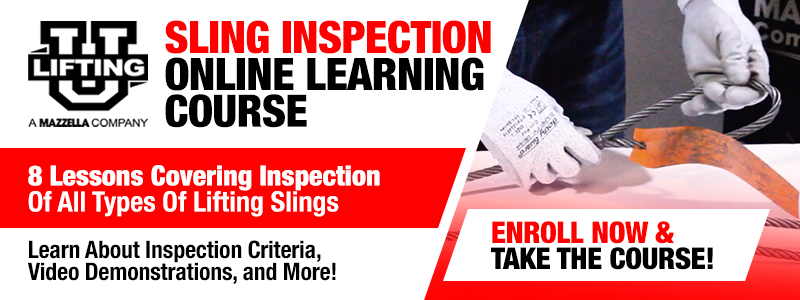
What Type of Rigging Equipment Gets Inspected?
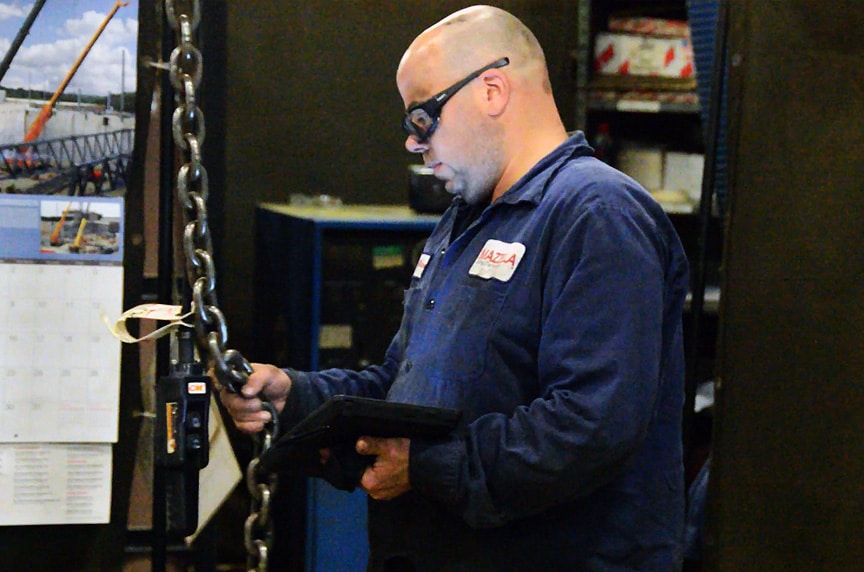
Ultimately, the type of gear being inspected comes down to the customer’s needs and wants. It may make the most economical sense to have the inspector or inspectors systematically go through all of your equipment at once to take advantage of their time and travel while they’re already on-site.
Over the course of an inspection, a rigging inspector can inspect any of the following product types:
- Lifting Slings: alloy chain slings, wire rope slings, synthetic roundslings, synthetic web slings, metal mesh chain slings, synthetic rope slings
- Rigging Gear: lever tools or chain falls (not permanently mounted), hoist rings, eye bolts, shackles, turnbuckles, hooks, etc.
- Below-the-Hook Devices: Lifting beams, spreader beams, c-hooks, die-handlers, etc.
- Personal Fall Protection: Harnesses, lanyards, and retractable devices
At the end of the inspection, you should receive a comprehensive inspection report that will give you insight into the effectiveness of your internal compliance programs and the training of your riggers and crane operators.
Remember, OSHA won’t penalize you for having gear that failed inspection and was removed from service. If anything, you can look at the numbers from your inspection reports and determine if there should be a larger investment in training for your riggers and operators. These types of reports can help you understand:
- Are your employees inspecting their gear before each shift? Inspecting their gear before each lift?
- Do they know how to properly inspect their gear?
- Can they identify damage or irregularities that require the product to be removed from service?
What Factors Affect the Cost of a Rigging Inspection?
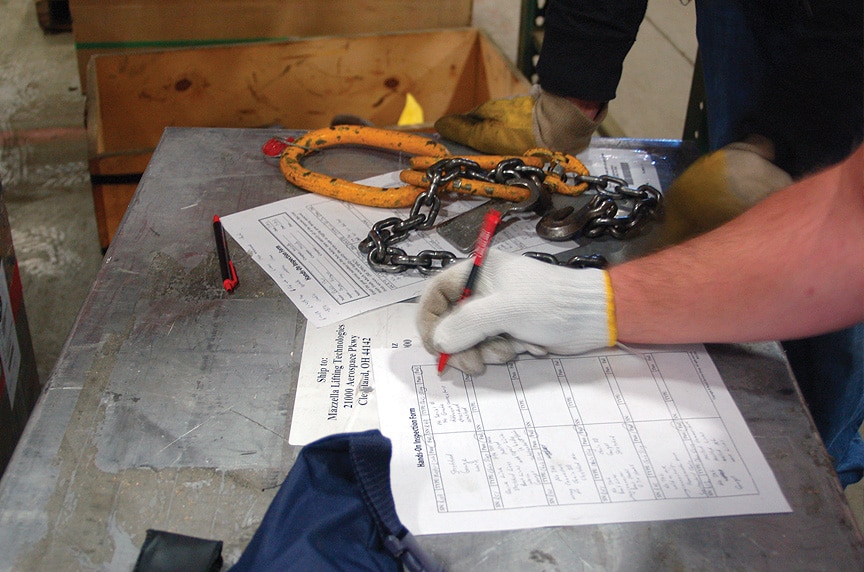
There are a few other factors that can affect the cost of a rigging inspection. All of the factors listed below can affect the overall cost of a rigging inspection in one way or another:
Special Equipment or Services
Will the inspector need to provide any type of special equipment for magnetic particle testing, or on-site proof testing? Will the inspector need to apply inspection tags to all material that was looked at during the course of the inspection?
Drive Time / Fuel
Drive time will be calculated based on the distance and time that it takes the technician to drive from their shop to the customer’s location.
Lodging / Meals
If an inspector has to travel to a location outside of their normal territory, or an inspection will last more than one day, then the customer may be required to pay for travel / lodging / meal costs.
Down Time / Wait Time
Any additional time that the inspector has to wait for a shift or production run to end before they can access the equipment will be charged at published hourly rates and fees.
Training
Is additional safety training required for an inspector to come on your job site or access your facility? Additional training will add on to the number of hours required for the inspection and increase costs. It’s best to let your rigging inspection provider know about this upfront so they can build it into their quote.
Environment
Abnormal or hazardous environments (chemical baths, hot metal, extreme heights, etc.) will require additional equipment and / or additional protection for an inspector to come on-site. It may even require an inspector with specialized training who is familiar with and qualified to work in an environment with potential hazards.
What is the Cost of a Rigging Inspection?
Every company that offers rigging inspection services has its own business model or set pricing. You may have even been offered a “free” rigging inspection in the past, and you’re confused about why you should pay for services that you can have performed at no cost from another provider. That’s a topic we’ve already covered in depth, but just understand that a company who performs free inspections of your rigging gear may not have your best interests in mind, and may not be able to provide you with:
- Full-time, independently-trained and certified inspectors
- Digital reporting outputs for ASME records retention requirements
- Logistics coordinators who reach out and proactively remind you to schedule your periodic inspection well in advance of the upcoming deadline
When you contact a rigging inspection provider, make sure you ask for their hourly rate, plus an estimate of the total number of hours required to complete the inspection process at your facility.
At a minimum, a four-hour rigging inspection could cost around $480. For a full-day, eight-hour rigging inspection, you could expect to pay around $960. Mazzella’s rate for a rigging inspection is around $120 / hour.
Anything longer than eight hours in a single day would add overtime pay to the total cost. A multi-day inspection would obviously cost more based on the total number of days (or hours) required, and the total number of inspectors required to complete the inspection in a timely manner.
Also, be prepared to replace or repair some of the rigging equipment that is found to be unfit for continued use during the course of an inspection. You may need to allocate additional funds to cover the cost of purchasing replacement slings, hooks, personal fall protection gear, etc.
How Can Mazzella Help With Your Rigging Inspections?
![How Much Does an OSHA/ASME Compliant Rigging Inspection Cost? [2022]: Mazzella Can Help](https://www.mazzellacompanies.com/wp-content/uploads/2022/03/article-how-much-does-an-osha-asme-compliant-rigging-inspection-cost-2022-mazzella.jpg)
Remember, bringing a third-party rigging inspector into your facility shouldn’t be considered an added expense, but instead, an investment in the safety of your employees. If you have the proper compliance processes in place, and your employees are properly trained, then a rigging inspection should really just be a validation of how well those programs are working.
If an inspector comes in and verifies that your rigging gear is in proper working condition—that shows your employees have been trained to identify damaged or failed products and they know what to do with that damaged product once it’s been identified.
On the reverse side, if you end up with a large amount of damaged rigging gear at the end of an inspection, use that as an opportunity to improve your internal processes. You may learn that this is an opportunity to provide more training for your employees.
Also, lean on the inspectors to help identify products that your employees may not be using properly or may not be the most practical for your lifting application. They can make recommendations based on best practices they’ve seen across all industries, and also, make recommendations for improvement based on their knowledge of the applicable ASME standards.
At Mazzella, we have a dedicated team of Rigging Inspectors that are independently trained and certified. Their only responsibility is to come on-site and perform a thorough inspection of your rigging gear, address solutions as required, and complete the service in a timely manner.
Our inspectors can help you identify compliance issues and identify opportunities for improvement based on their thorough understanding of all applicable OSHA and ASME standards.
If you’re interested in learning more about our inspection services, contact us today. We can partner with you to ensure the peace of mind that safety compliance brings.
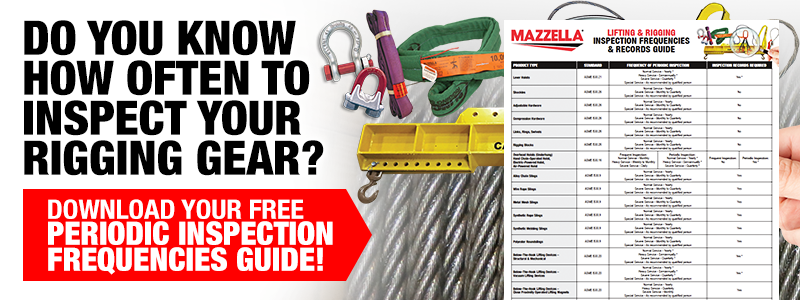
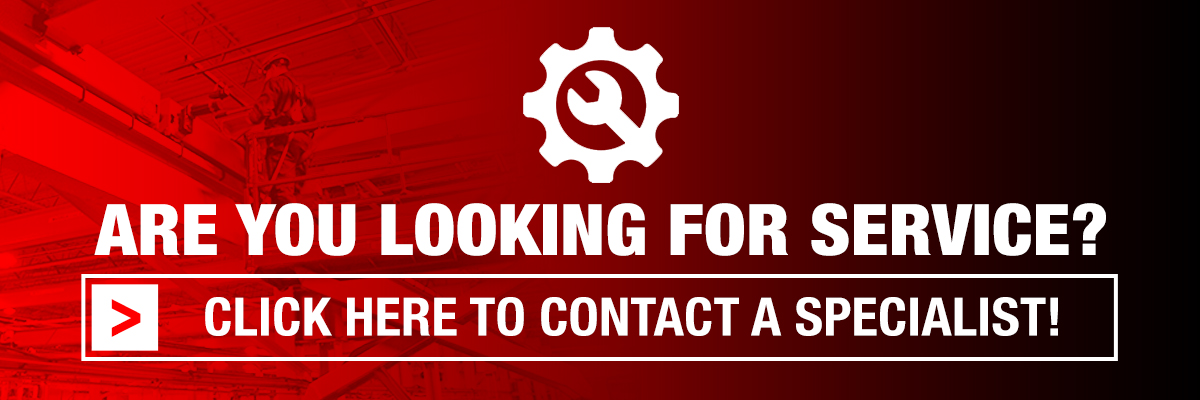
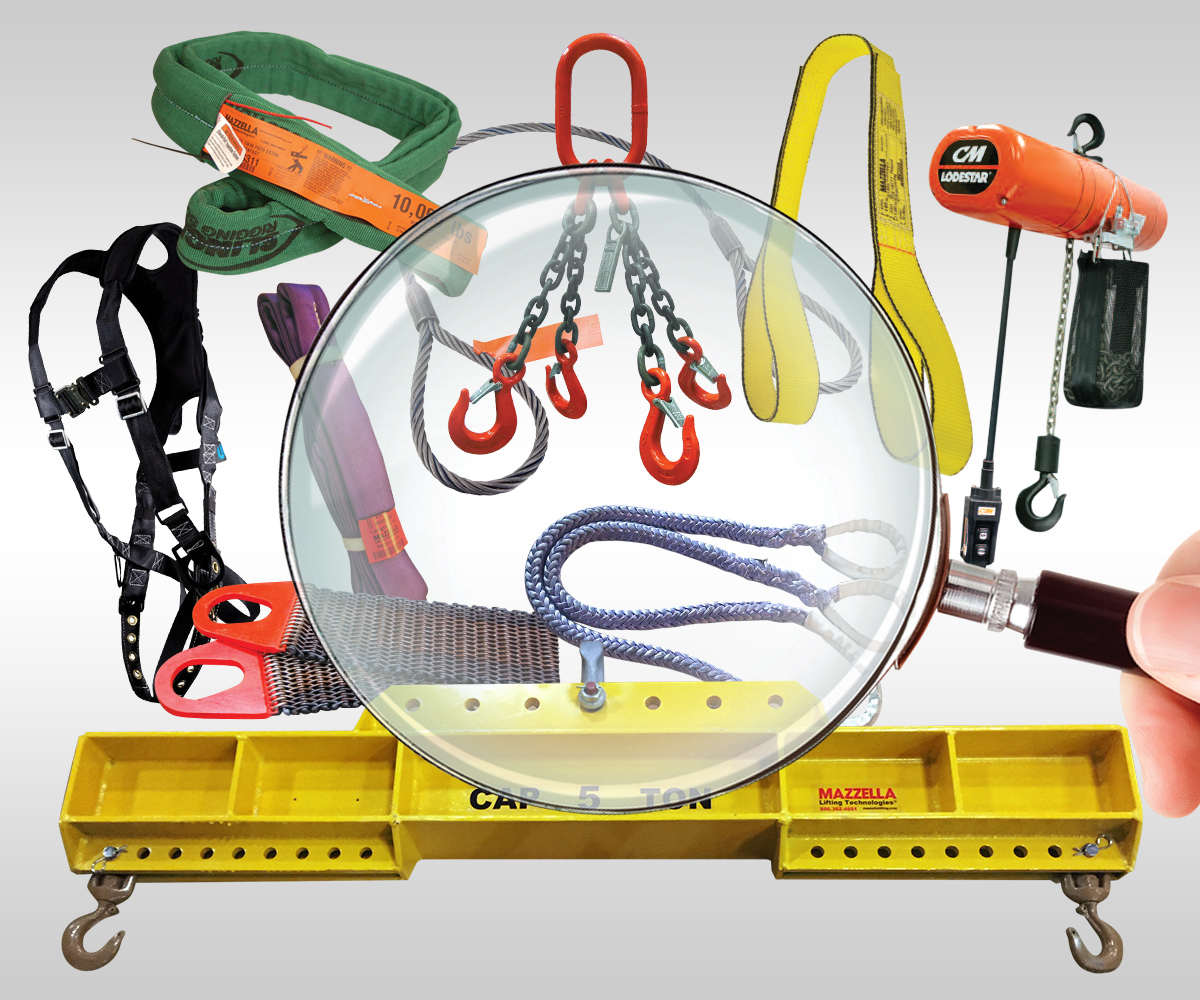
Rigging Inspection Services
OSHA 1910.184, ASME B30.9, B30.20, B30.26, & ANSI Z359 require periodic, documented inspections on slings, rigging hardware, lifting devices, and fall protection every 12 months, at minimum, and monthly to quarterly in more severe service conditions.
Call us at 800.362.4601 or click here if you need inspections for slings, rigging hardware, lifting devices, or fall protection!
Copyright 2022. Mazzella Companies.
